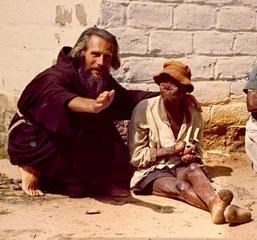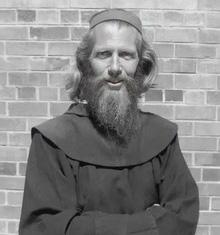
3 minute read
A Saint in the Sacristy?
John Bradburne is one whose cause for canonization is progressing quickly. Born in Cumbria in 1921, a soldier in India, Malaya and Burma during the Second World War, a poet, a convert to Catholicism and a pilgrim, he spent the final decade of his life ministering both physically and spiritually in a leper camp in Zimbabwe, refusing to leave despite the increasing violence that surrounded the Zimbabwean struggle for independence, violence that would claim his life in 1979. In this extract from his latest book, Fr Gerard explores the years that Bradburne worked at the Cathedral and for the Archbishop of Westminster.
In late October 1956, Bradburne asked for a job in the Burns & Oates bookshop across the road from Westminster Cathedral. With Christmas approaching, the shop’s manager was looking for extra hands for the seasonal surge in business and gladly took Bradburne on. He offered his services to the Cathedral Choir too, which were politely declined, but, in the New Year, he was more successful in obtaining the position of fifth sacristan. While the work was congenial to him, he was less than perfect in ensuring that cruets, books and vestments were always in the right place at the right time. All the same, the head sacristan of the time spoke of Bradburne as: ‘One of the most lovable men I ever knew … a most conscientious worker’. In the Cathedral the newly appointed archbishop, William Godfrey, also seems to have noticed John and would spend time with him, amiably chatting as the sacristan went about his duties and the archbishop paused between his long periods of prayer.
In his spare time Bradburne still wandered the streets playing his recorder. If he was given any money by passers-by, he would give it to beggars or put it in the St Vincent de Paul collection box. On one occasion he was seen by a Cathedral parishioner playing his recorder outside St Paul’s Cathedral. The parishioner mentioned this to the Cathedral Administrator who quickly took Bradburne to task for bringing Westminster’s reputation into disrepute by begging outside the Anglican cathedral. Bradburne explained that he wasn’t begging but simply playing Marian hymns, giving any proceeds to the poor.

By the summer of 1957, Archbishop Godfrey invited Bradburne to become the caretaker of his country house at Hare Street, a Hertfordshire village some 40 miles from London. This residence had been left to the Archbishops of Westminster by the Benson family, having been owned by Robert Hugh Benson, a renowned convert, priest and writer who was also the son of an Archbishop of Canterbury. The setting must, at first, have seemed ideal to Bradburne. Whilst at the Cathedral he had lived in either miniscule lodgings or shared rooms in a small flat; Hare Street House and its garden gave John much more space, not least because, for the most part, he was the solitary resident, the archbishop and his staff usually being resident in Westminster. ‘It is heaven to be alone with God’, he wrote, ‘Heaven albeit with a heavy cross – that of being alone all with oneself.’ He continued to live as frugally as he always had, the account set up in his name revealing an unrelieved diet of baked beans, bread and margarine, and his writing of poetry burgeoned.
When Archbishop Godfrey was staying at Hare Street, John would often serve his Mass and seek him out for conversation, seeing the archbishop as a holy man ‘always up the mountain with God’. Relations with the archbishop’s secretary, Mgr Derek Worlock (the future Archbishop of Liverpool), were not as cordial, the characters of the two men being so vastly different, yet the Monsignor did much to make sure that Bradburne was as comfortable as possible in his role as caretaker. When the archbishop was not in residence, Bradburne would make his way to Buntingford, two miles away, for the early morning Mass before returning to work for the morning. He would sometimes lock himself away for a week at a time for prayer and meditation. At other times he would practice on the harmonium in the house’s chapel, where Robert Hugh Benson was buried or spend time reading Benson’s novels.
Indeed, he became so immersed in the novels of Benson and felt himself so imbued by his spirit that he became very protective of the house as it had been left by Benson: alterations were not welcomed. This quickly led to altercations between John and Mgr Worlock’s architect, George Mathers (who designed churches in St Albans South in 1962, Hatfield in 1970 and South Harrow in 2002). With Archbishop Godfrey being created a Cardinal and approving a wholesale restoration of the house, Mgr Worlock came to inspect ongoing work up to three times a month, increasing tensions between caretaker and the Cardinal’s secretary. On the whole, when they met, Bradburne was civil to Worlock, but in letters he could be blisteringly brusque. Ultimately he could bear what he saw as the destruction of the house no longer and, on 21 October 1961, he took leave of his employment, quietly leaving Hare Street just after Cardinal Godfrey had arrived, being sure that the Blessed Sacrament in the Chapel was not left unguarded. In August of the following year, Bradburne travelled to Southern Rhodesia, as it was then called. He was, finally, edging towards the leper colony where he would fully realise his God-given vocation in life and in whose defence he would ultimately be killed.
Fr Gerard Skinner is the author of John Bradburne – Soldier, Poet, Pilgrim published by the Catholic Truth Society.








